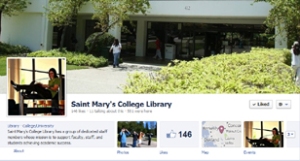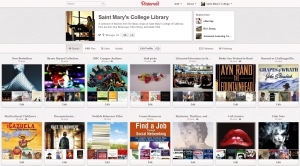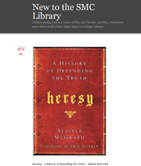Are We Burying Our Heads In the Sand?
A realistic reflection on the future of the library profession
Elise Y. Wong
Since the economic recession hit in 2008, library workers around the country have been hearing devastating stories about the impact on hiring freezes, layoffs, budget cuts, furloughs. Articles such as Forbes’s “The Best and Worst Master’s Degrees for Jobs” and “Come to Library School! Just Don’t Expect a Job!” by Library Journal’s columnist Annoyed Librarian are especially disheartening to read. I started my first professional librarian position in December 2009, about six months after graduation. Based on what I have heard from fellow MLIS graduates, some of them have either stayed at their current paraprofessional jobs, or relocated after finding a librarian job out of town. Many of them are still looking for library professional jobs that are comparable to their expectations. Having been at my job for more than three years now and preparing for my academic review, I constantly reflect on the future of my career development and the outlook of the library profession. As information and library professionals in various capacities, it is imperative that we address the social and economic aspects of both librarianship and library job market trends, and share that knowledge with prospective (or current) library students and recent MLIS graduates.
Do your research: what does statistics tell us?
Most first-year library students enrolled in an MLIS program prior to 2008 had a good perception of their future career as librarians. Since librarianship is known to be “a graying profession,” many of us thought that there is no need to worry about shortage of librarians. In the mean time, the business of online MLIS programs is booming. According to ALA Statistics report, “Summary of Changes in ALA-Accredited Programs Fall 2010 – Fall 2011,” there are 19,128 MLIS students in 63 accredited MLIS programs (American Library Association, 2012, August 14). The Digest of Education Statistics recorded that 7727 Master’s degrees in library science were conferred 2010-2011 (National Center for Education Statistics, 2012). These statistics, along with the continuing economic recession since 2008, made me wonder whether the market will soon be flooded with too many MLIS graduates and there won’t be enough jobs to go around for prospective librarians.
During the past two years I was on two search committees to hire paraprofessionals. We received over 60 applications for each opening and over 70% were MLIS candidates. My colleague on a search committee for a temporary full time reference and instruction librarian reported that the committee received over 70 applications. These anecdotes seem to suggest that MLIS graduates have become very competitive for librarian jobs, some even going after the support positions.
One can easily compile a list of reputable statistical sources on the labor and employment of the library profession. The ALA’s Labor Trends and Statistics for Library Workers page (American Library Association, 2013) provided various statistics from Bureau of Labor Statistics and U.S. Department for Professional Employees, AFL-CIO. According to the latter, there were 198,000 librarians, 37,000 library technicians, and 140,000 other education, training, and library workers in 2011 (Department for Professional Employees, AFL-CIO, 2012). The Occupation Outlook Handbook estimated that the employment growth rate for librarians will be 7% by 2020, compared to 10% for library technicians and assistants (Bureau of Labor Statistics, 2012a, 2012b). The Occupational Information Network (O*NET), a program developed by the US Department of Labor/Employment and Training Administration, projected that by 2020 there will be 51,400 job openings for librarians, and 59,500 to 64,100 for library technicians/assistants (O*NET OnLine, 2010a, 2010b).
Many MLIS students and prospective MLIS graduates are given the impression that librarianship is an aging profession, and there will be plenty of jobs available in the next 5 to 10 years. Indeed, the 1999 studies conducted by ALA Office of Research and Statistics confirmed that librarianship is on the road of becoming a “graying profession” (Lynch, 2013). The 2009 ALA report, “Planning for 2015: The Recent History and Future Supply of Librarians” continued to explore the retirement wave. The report found that as of 2005, over 40 percent of 104,600 “credentialed” librarians are between the ages of 50 and 59. The report estimated that by 2015, 30,500 librarians (30%) will be above age 60, while 26,000 to 30,000 (27%) librarians will reach age 50-59. 28,200 retirements were projected among credentialed librarians between 2005 and 2015. This means that the profession may lose an average of 2,820 librarians each year to retirement (Davis, 2009). We know from Digest of Education Statistics that 7,727 Master’s degrees in Library Science were conferred 2010-2011. If we assume that the same amount of Master’s degrees in library science will be conferred each year, the supply of vacant librarian positions according to the ALA’s report (i.e. an average of 2820), will not be able to match the demand of the incoming MLIS graduates.
Reevaluate your perspective
There is no question that libraries and librarianship are undergoing economic hardship. Like other information workers, MLIS students, recent MLIS graduates, and new librarians make thoughtful considerations as we enter the library profession. Now that the economic recession has become a persistent financial variable on the library job market, it is necessary that we reevaluate our perception of the value of the degree as well as our expectations on career advancement in librarianship.
One of the questions that we need to ask ourselves is whether we have changed our minds about becoming librarians. If the answer is no, we should prepare ourselves to face the harsh economic reality and the emotional challenges associated with it. Library Journal’s “LJ 2011 Job Satisfaction Survey,” analyzed some of the frustrations experienced by library workers across the field. According to the survey, the top three dissatisfactions were: low pay, management issues, and budget crunch. Library workers constantly struggle with job stress and low morale. Despite the complaints, 70 percent of library workers across all library types and at all levels were satisfied about their jobs and remain optimistic about the future. Over 60% of survey respondents still think that an MLIS degree is essential or very essential for library career advancement (Miller, 2011, June 1).
Library Research Service (a unit of Colorado Public Library) also conducted a survey on the perception of the value of MLIS degree among Colorado librarians. On the whole, most Colorado librarians remained optimistic of the value of their MLIS degree. 79% of survey respondents agreed that their MLIS degree is worth investing the time and money, and 63% of the respondents would indeed recommend the MLIS degree today. However, among those who have had their degree for 1-5 years, only 49% of them would recommend getting the degree, and 35% indicated that they would not recommend or actively dissuade others from pursuing an MLIS (Teglovic, Jordan-Makely, Boyd, & Hofschire, 2012, June). These lower numbers most likely showed the impact of the economic downturn on librarians’ perception of the value of their MLIS degree.
It is a tough job market for new library information workers. Library Journal’s “Placements and Salaries Survey 2012” provided an in-depth analysis on library job prospects based on its survey on recent MLIS graduates. The survey estimated the unemployment rate among MLIS graduates at 6.8%, but only 75.4% of current graduates had full time placements (Maatta, 2012, October 15). Despite the challenges, the survey advised graduates to broaden their library experiences and open their job hunt to positions outside of the library field. Given the current economic recession, it is reasonable to assume that it will take longer for MLIS graduates to land their first professional librarian position.
Think outside the box
Many new MLIS graduates are frustrated that they cannot find a librarian position that meets their expectations. Each of us has our own reservations and preferences regarding the pay scale, commute distance, and types of the library jobs we want to pursue. Moreover, the economy is not making job hunting easier. Two frequently asked questions among new MLIS graduates are: (1) What should I do if I cannot find a professional position in libraries after I complete my MLIS degree? (2) What can I do with my MLIS degree without becoming a librarian?
Some new MLIS graduates who are currently working in libraries choose to stay at their paraprofessional positions while they are searching for librarian jobs. In the mean time, hiring supervisors are seeing many candidates with an MLIS degree applying for library technician positions. While many supervisors are reluctant to consider MLIS candidates for such positions, some give these candidates a fair chance and interview them the same as other non-MLIS candidates. Confronted by the lack of employment in the current job market, these new graduates may have to accept jobs for which they are over-qualified. It is understandable why some new MLIS graduates may feel de-valued if they have to work as paraprofessionals.
In certain institutions, the barrier (in terms of job responsibilities) between a library professional and paraprofessional is blurring. In spite of their frustrations, MLIS graduates may find that being a paraprofessional or a paralibrarian[1] is not as devastating as they thought if their workplace provides support for paralibrarians to further their professional development. For new MLIS graduates who do not have much library work experience prior to their degree, starting their library career as a paralibrarian can be a rewarding experience in preparation of becoming a full-fledge librarian in the future. Some MLIS graduates who are in need of a job are broadening their job searches to include non-library areas of expertise. According to Breitkopf’s article, “61 Non-Librarian Jobs for LIS Grads,” MLIS graduates should not limit their job search to just libraries (Breitkopf, 2011, December 23). Although some jobs do not necessarily require an MLIS degree, an MLIS degree is marketable in many information or education fields, such as museums, archives, vendors, publishers, digital systems, government agencies, Web technologies, teaching, and researching. In light of competition among job applicants, MLIS holders need to be proactive and creative in applying for jobs, taking extra care to tailor their resumes and cover letters to match the employers’ hiring qualifications.
Transform options into action
MLIS graduates who want to land the library jobs they desire need to be more determined and competitive than ever. Once we have weighed our options and prepared ourselves to have the right attitude to face the future, we must come up with an action plan that will sustain the value of our MLIS degree. As we are waiting to be hired or searching for the perfect job, we need to maintain confidence and display a positive attitude during the job searching process. It is essential that we keep ourselves updated on library trends by reading library literature, magazines, and online media. We should consider extending our skills and professional experience by interning or volunteering at other information organizations. Whenever possible, we should attend local and regional library conferences and be actively involved in professional activities. We should strive to build a network of connections among mentors and colleagues, as a well-established network is a valuable resource for new MLIS graduates and librarians to reach out and help one another.
Reshape the future of librarianship
The mission of educating the current and future MLIS graduates rests on the shoulders of librarians, librarian educators, and administrators of MLIS programs. It is our responsibility to prepare new and future librarians to reflect on the strengths, challenges, and opportunities in the profession as they embark on the road to librarianship. The sustainability of library profession depends on how we can cope with the fluctuating job market and adapt to the changing perception of the value of librarianship. Library and information professionals need to maintain an on-going discussion on evaluating the dynamic career outlook of the library profession and assessing the various ways to balance the supply and demand of the library labor workforce, in order to ensure that future managers and leaders are equipped with the necessary knowledge and experience to thrive in the information age.
References
American Library Association. (2012, August 14). Statistical reporting: Summary of changes in ALA-Accredited programs fall 2010 – fall 2011. Retrieved March 13, 2013 from http://www.ala.org/accreditedprograms/sites/ala.org.accreditedprograms/files/content/standards/ss2010v2011.pdf
American Library Association. (2013). Labor trends and statistics for library workers. Retrieved March 13, 2013 from http://www.ala.org/educationcareers/careers/stats
Breitkopf, M. (2011, December 23). 61 Non-Librarian Jobs for LIS Grads. Retrieved March 13, 2013 from http://infospace.ischool.syr.edu/2011/12/23/61-non-librarian-jobs-for-librarians/
Berry, J. N. (2010, March 1). Allison Sloan: Paraprofessional of the year 2010. Retrieved March 13, 2013 from Library Journal Website: http://www.libraryjournal.com/article/CA6719424.html
Bureau of Labor Statistics. (2012a). Librarians: Summary. Retrieved March 13, 2013 from Occupation Outlook Handbook Website: http://www.bls.gov/ooh/Education-Training-and-Library/Librarians.htm
Bureau of Labor Statistics. (2012b). Library technicians and assistants: Summary. Retrieved March 13, 2013 from Occupation Outlook Handbook Website: http://www.bls.gov/ooh/education-training-and-library/library-technicians-and-assistants.htm
Davis, D. M. (2009). Planning for 2015: The recent history and future supply of librarians. Retrieved March 13, 2013 from American Library Association Office of Research and Statistics website: http://www.ala.org/research/sites/ala.org.research/files/content/librarystaffstats/recruitment/Librarians_supply_demog_analys.pdf
Department for Professional Employees, AFL-CIO. (2012). Library workers: Facts and figures, fact sheet 2012. Retrieved March 13, 2013 from http://dpeaflcio.org/programs-publications/issue-fact-sheets/library-workers-facts-figures/
Library Journal. (2013). Paralibrarian of the year nomination guidelines. Retrieved March 13, 2013 from http://lj.libraryjournal.com/awards/paralibrarian-of-the-year-nomination-guidelines/
Lynch, M. J. (2013). Age of librarians. Retrieved March 13, 2013 from American Library Association Office for Research and Statistics Website: http://www.ala.org/ala/research/librarystaffstats/librarystaffstudies/ageoflibrarians.cfm
Maatta, S. (2012, October 15). A job by any other name | LJ’s placements and salaries survey 2012. Retrieved March 13, 2013 from http://lj.libraryjournal.com/2012/10/placements-and-salaries/2012-survey/a-job-by-any-other-name-ljs-placements-salaries-survey-2012/
Miller, R. (2011, June 1). LJ 2011 Job Satisfaction Survey | Rocked By Recession, Buoyed. Retrieved March 13, 2013 from Library Journal Website: http://www.libraryjournal.com/lj/careerscareernews/890617-300/lj_2011_job_satisfaction_survey.html.csp
National Center for Education Statistics. (2012). Table 287. Master’s degrees conferred by degree-granting institutions, by field of study: Selected years, 1970-71 through 2010-11. Retrieved March 13, 2013 from Digest of Education Statistics Website: http://nces.ed.gov/programs/digest/d12/tables/dt12_287.asp
O*NET OnLine. (2010a). Summary report for librarians. Retrieved March 13, 2013 from http://www.onetonline.org/link/summary/25-4021.00
O*NET OnLine. (2010b). Summary report for library technicians. Retrieved March 13, 2013 from http://www.onetonline.org/link/summary/25-4031.00
Teglovic, J., Jordan-Makely, C., Boyd, L., & Hofschire, L. (2012, June). What is the value of an MLIS to You? Retrieved March 13, 2013 from Library Research Service Website: http://www.lrs.org/documents/closer_look/MLIS_Value_Closer_Look_Report.pdf
[1] A term endorsed by Massachusetts Library Association and American Library Association, and later adopted in Library Journal’s “Paralibrarian of the Year” award in 2011. See: Berry (2010, March 1) and Library Journal (2013).


